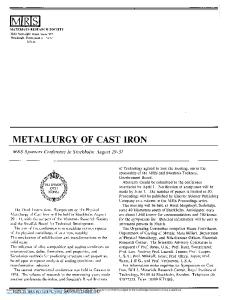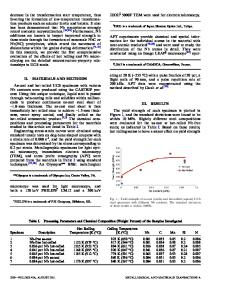The effect of rolling on graphitization characteristics of strip cast Fe-C-Si white cast iron
- PDF / 1,911,455 Bytes
- 7 Pages / 612 x 792 pts (letter) Page_size
- 53 Downloads / 297 Views
I. INTRODUCTION
PREVIOUS works have directly produced cast iron strips from molten metal by using the unequal-diameter twinroller (UDTR) strip casting process.[1,2] The cooling rate of the strips was estimated to range from 102 8C to 103 8C/s, which is obviously faster than conventional gravity casting. An extremely fine solidification structure comprising a large quantity of eutectic cementite could be observed. To get acceptable workability, graphitization treatment of cast iron strips should be performed. Our previous investigation[2] demonstrated that the finer solidification structure of white cast iron strips promotes a faster graphitization rate. However, the complete annealing time, including first- and second-stage graphitization (FSG and SSG) is still longer than desired. Therefore, it is important to explore the conditions for accelerating graphitization. Previous investigations have reported on the feasibility of promoting first-stage graphitization by predeformation.[3–7] Plenard and Formont[3] confirmed that high intensity compressive prestressing of white cast iron by special punches reveals more and finer graphite nodules in the stress-affected zone in the final structure after graphitization. Lee et al.[4] also investigated the effect of predeformation in ambient temperature on graphitization of white cast iron treated with Mg or S, indicating that predeformation definitely can increase the number of graphite particles after annealing. Moreover, the effect of hot impact or hot forging at 1100 8C on the graphitization characteristics of white cast iron has also been investigated.[5,6,7] Yamamoto et al.[5] reported that the graphitization of white iron samples did not occur when the thickness reduction was less than 70 pct, but drastic graphitization happened almost instantly with a larger thickness reduction ratio over 70 pct. This massive graphitization has been attributed to the collapse of cementite crystals due to the breakage of covalent Fe-C bonds.[5] According to J.M. SONG, Graduate Student, and T.S. LUI and L.H. CHEN, Professors, are with the Department of Materials Science and Engineering, National Cheng Kung University, Tainan, Taiwan 70101, Republic of China. B.C. KUO, formerly Graduate Student, Department of Materials Science and Engineering, National Cheng Kung University, is with Thye-ming Industrial Company, Kaohsiung, Taiwan 831, Republic of China. Manuscript submitted February 1, 1999. METALLURGICAL AND MATERIALS TRANSACTIONS A
Chakrabarti et al.,[6] hot forging led to a breakdown of massive carbides and dispersed the carbide phases throughout the matrix, thus increasing the austenite/carbide interfacial area and the number of temper graphite nodules. However, it is essential to clarify the effect of prerolling on graphitization characteristics of white iron strips during FSG. Despite the fact that strip casting is a near-net-shape process, rolling is still necessary to obtain precise strips. The lack of quantitative studies on the graphitization of white cast iron strip, particul
Data Loading...










